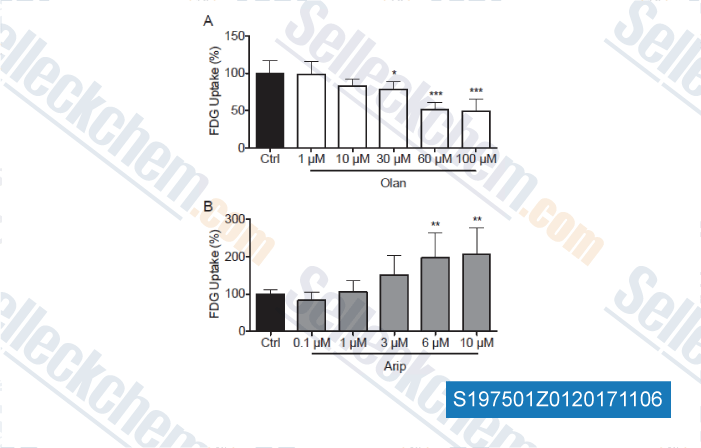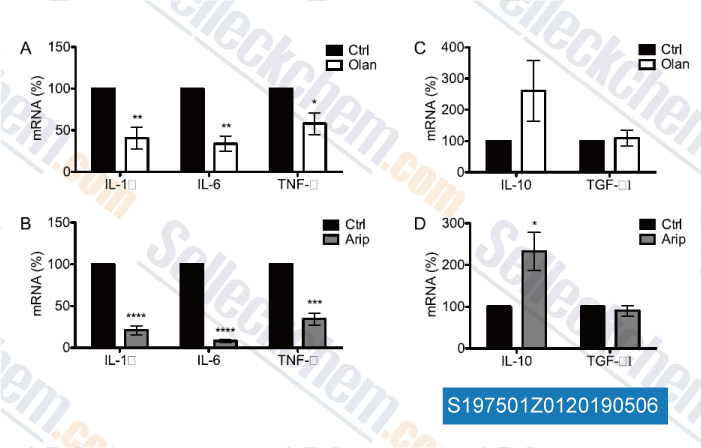|
Toll Free: (877) 796-6397 -- USA and Canada only -- |
Fax: +1-832-582-8590 Orders: +1-832-582-8158 |
Tech Support: +1-832-582-8158 Ext:3 Please provide your Order Number in the email. |
Technical Data
| Formula | C23H27Cl2N3O2 |
|||
| Molecular Weight | 448.39 | CAS No. | 129722-12-9 | |
| Solubility (25°C)* | In vitro | DMSO | 90 mg/mL (200.71 mM) | |
| Water | Insoluble | |||
| Ethanol | Insoluble | |||
|
* <1 mg/ml means slightly soluble or insoluble. * Please note that Selleck tests the solubility of all compounds in-house, and the actual solubility may differ slightly from published values. This is normal and is due to slight batch-to-batch variations. * Room temperature shipping (Stability testing shows this product can be shipped without any cooling measures.) |
||||
Preparing Stock Solutions
Biological Activity
| Description | Aripiprazole (OPC-14597) is a novel atypical antipsychotic drug that is reported to be a high-affinity 5-HT receptor partial agonist. | ||
|---|---|---|---|
| Targets |
|
||
| In vitro | Aripiprazole binds with high affinity to both the G protein-coupled and uncoupled states of receptors. Aripiprazole potently activates D2 receptor-mediated inhibition of cAMP accumulation. [1] Aripiprazole has highest affinity for h5-HT(2B)-, hD(2L)-, and hD(3)-dopamine receptors, but also has significant affinity (5-30 nM) for several other 5-HT receptors (5-HT(1A), 5-HT(2A), 5-HT(7)), as well as alpha(1A)-adrenergic and hH(1)-histamine receptors. Aripiprazole has less affinity (30-200 nM) for other G protein-coupled receptors, including the 5-HT(1D), 5-HT(2C), alpha(1B)-, alpha(2A)-, alpha(2B)-, alpha(2C)-, beta(1)-, and beta(2)-adrenergic, and H(3)-histamine receptors. Aripiprazole is an inverse agonist at 5-HT(2B) receptors and displays partial agonist actions at 5-HT(2A), 5-HT(2C), D(3), and D(4) receptors. [2] | ||
| In vivo | Aripiprazole reduces extracellular 5-HIAA concentrations in the medial prefrontal cortex and striatum of drug-naive rats, but not in chronic Aripiprazole-pretreated rats. [3] Aripiprazole, 0.1 mg/kg and 0.3 mg/kg, significantly increases dopamine release in the hippocampus of rats. Aripiprazole, 0.3 mg/kg, slightly but significantly increases dopamine release in the medial prefrontal cortex but not in the nucleus accumbens. Aripiprazole, 3.0 mg/kg and 10 mg/kg, significantly decreases dopamine release in the nucleus accumbens but not the medical prefrontal cortex. Aripiprazole, 0.3 mg/kg, transiently potentiates haloperidol (0.1 mg/kg)-induced dopamine release in the medial prefrontal cortex but inhibited that in the nucleus accumbens. [4] |
Protocol (from reference)
References
Customer Product Validation

-
Data from [Data independently produced by , , J Psychiatr Res, 2017, 88:18-27 ]

-
Data from [Data independently produced by , , J Psychiatr Res, 2018, 105:95-102]
Selleck's Aripiprazole has been cited by 15 publications
| Low-Dose Perifosine, a Phase II Phospholipid Akt Inhibitor, Selectively Sensitizes Drug-Resistant ABCB1-Overexpressing Cancer Cells [ Biomol Ther (Seoul), 2025, 33(1):170-181] | PubMed: 39632683 |
| Chronic Aripiprazole and Trazodone Polypharmacy Effects on Systemic and Brain Cholesterol Biosynthesis [ Biomolecules, 2023, 10.3390/biom13091321] | PubMed: 37759721 |
| Chronic Aripiprazole and Trazodone Polypharmacy Effects on Systemic and Brain Cholesterol Biosynthesis [ Biomolecules, 2023, 13(9)1321] | PubMed: 37759721 |
| Individual and simultaneous treatment with antipsychotic aripiprazole and antidepressant trazodone inhibit sterol biosynthesis in the adult brain [ J Lipid Res, 2022, 63(8):100249] | PubMed: 35839864 |
| JAK2 Inhibitor, Fedratinib, Inhibits P-gp Activity and Co-Treatment Induces Cytotoxicity in Antimitotic Drug-Treated P-gp Overexpressing Resistant KBV20C Cancer Cells [ Int J Mol Sci, 2022, 23(9)4597] | PubMed: 35562984 |
| Terconazole, an Azole Antifungal Drug, Increases Cytotoxicity in Antimitotic Drug-Treated Resistant Cancer Cells with Substrate-Specific P-gp Inhibitory Activity [ Int J Mol Sci, 2022, 23(22)13809] | PubMed: 36430288 |
| Effects of Psychotropic Medication on Somatic Sterol Biosynthesis of Adult Mice [ Biomolecules, 2022, 12(10)1535] | PubMed: 36291744 |
| Characteristics of Psychotic Depression in Juveniles and Analyzing 4 Antipsychotics [ Journal of Student Research, 2022, 11(4).] | PubMed: none |
| Social-like responses are inducible in asocial Mexican cavefish despite the exhibition of strong repetitive behavior [ Elife, 2021, 10e72463] | PubMed: 34542411 |
| Inhibition of Arenaviruses by Combinations of Orally Available Approved Drugs [ Antimicrob Agents Chemother, 2021, AAC.01146-20] | PubMed: 33468464 |
RETURN POLICY
Selleck Chemical’s Unconditional Return Policy ensures a smooth online shopping experience for our customers. If you are in any way unsatisfied with your purchase, you may return any item(s) within 7 days of receiving it. In the event of product quality issues, either protocol related or product related problems, you may return any item(s) within 365 days from the original purchase date. Please follow the instructions below when returning products.
SHIPPING AND STORAGE
Selleck products are transported at room temperature. If you receive the product at room temperature, please rest assured, the Selleck Quality Inspection Department has conducted experiments to verify that the normal temperature placement of one month will not affect the biological activity of powder products. After collecting, please store the product according to the requirements described in the datasheet. Most Selleck products are stable under the recommended conditions.
NOT FOR HUMAN, VETERINARY DIAGNOSTIC OR THERAPEUTIC USE.
